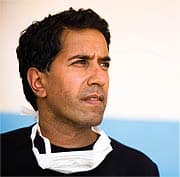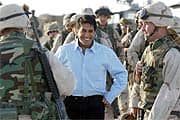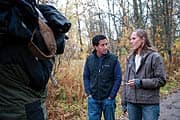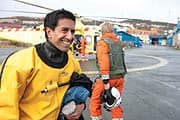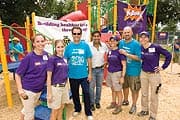Life Extension Magazine®
On the front lines of medicine as a practicing neurosurgeon and chief medical correspondent for CNN, Sanjay Gupta, MD reports on innovative medical breakthroughs that promise to save lives. In researching his book titled Cheating Death (Wellness Central, 2009), Dr. Gupta examines medical practices that were once deemed as science fiction, but are now becoming reality. In this candid interview, Dr. Gupta explores the frontiers of clinical medical practice where courageous doctors are reviving those who most in the medical establishment consider to be permanently “dead.” It is gratifying to read Dr. Gupta’s descriptions about some of the death-defying cooling and resuscitation technologies that the Life Extension Foundation® long ago pioneered. LE: In your new book, Cheating Death, you report on medical innovations that promise to extend our lives. Many of these ideas, such as hypothermia and suspended animation, were thought to be solely in the realm of science fiction. However all this is changing and we seem to be on the cusp of a new paradigm of emergency medicine. SG: You’re absolutely right. If you look back just twenty years ago many of these applications were considered to be completely crazy, such as hypothermia during cardiac operations for transplantation. When I was working on my previous book, Chasing Life, I thought a lot about the science of life extension and that got me thinking that we really don’t know how to define death. This is the key concept on life extension—when is death absolutely final and what is reversible? Every day we are learning a lot more in terms of how we can cheat death in cases of cardiac arrest. Twenty five years ago a heart attack was a more certain death sentence than it is today. Our concepts of when a person is salvageable are changing rapidly. LE: Your chapter on hypothermia is particularly fascinating. What was so surprising was the establishment’s resistance to the very simple, inexpensive and life-saving concept of simply cooling down the body to preserve its functions during trauma.
SG: I was really surprised as well and had no idea of the political ramifications of what I was writing. I’ve been overwhelmed by e-mails from people who are involved with this on both sides of the issue. The application of hypothermia is so simple that it’s almost unbelievable. If you look at your chance of surviving cardiac arrest as you’re walking down the streets of your neighborhood and nobody helps you, they are about 2 to 3%. Now, if somebody helps and let’s say calls 911, it goes up to around 10%. But if someone does simple chest compression and you add hypothermia, you can get a 700-800% increase in survival! There should be no argument on this. LE: Those are extraordinary statistics. There should be a national initiative to educate people on how easy it is to save lives. SG: Absolutely, I completely agree. In New York City, paramedics are being trained with these techniques. In several cities in Arizona paramedics not only have defibrillators and their bag of meds but more importantly, they have ice chests full of cool saline so they can immediately start the hypothermic process in the field. LE: The idea that more lives can be saved by a simple technology employing ice is very exciting. Throughout the book as you explore medical innovation you also come up against the conservatism of medicine. Sadly, it seems that people come into the ER with a poor prognosis and many times the doctor responds that the patient is in a catastrophic situation and any life-saving measure such as hypothermia isn’t going to work, so why bother? SG: This does happen. My reporting was not meant to indict the medical establishment in any way. My intention was to highlight an important premise which is that some of our greatest medical innovations have occurred when everyone said, “That’s not a fixable situation, I can’t save that person, can’t help that person,” and then someone just says, “You know what, let’s just try this.” LE: This is the basis of medical invention. SG: Chemotherapy was that way for Hodgkin’s lymphoma. This idea of giving a radical drug that would essentially take someone’s basic ingredients, or cells, to the point of death, only to hopefully select out the most deadly of all and leave the other ones to survive, was unheard of. But then it worked. Transplantation had to undergo a similar revision in thinking. And I think we’re going to look back at some of these medical advances and say, “That’s how we learn. That’s how medical knowledge is furthered in some way.” LE: In the book you discuss a patient who was in a coma for 19 years, and against all medical textbook knowledge grew new brain connections. SG: Right. And this is my world. I’m a neurosurgeon and I was taught in medical school that there are two types of cells in the body that never regenerate: neurons and cardiac cells (cardiac myoblasts). We now know that to not be true. You can form new cells, and not only can you do it in the brain, but we’re now getting a lot of evidence that you can also do it in the spinal cord as well. Imagine what the profound ramifications of this information will be? But going back to the patient that grew new brain cells, most doctors would say, “This guy had a terrible brain injury with no chance of recovery,” yet he did. So they label him an outlier. What I tried to do in this book with reports on various remarkable patients was to try to figure out the millions of microdecisions that were made that somehow let this person live when no one thought they would, or have function when no one thought they would. LE: What were some of the most fascinating cases you came across? SG: In the book I report on a patient diagnosed with glioblastoma. The vast majority of people in the neuroncology world will say, “Glioblastoma? Gee, I’m sorry to tell you that the average survival is 14 months, we haven’t made any progress, get your affairs together.” That’s the mantra that you hear way too often. And then you have a place like Duke, where they say, “There is hope, and based on that, we are going to never make you a DNR (do not resuscitate), we are always going to keep trying, we will throw the kitchen sink at you.” And do they have patients that die? Absolutely. But they have a higher subset of patients who live longer as a result of that. It is a different way of thinking from most of the medical establishment.
LE: It would seem that it is a fundamental responsibility of the medical profession to keep pushing the envelope, because that’s how knowledge progresses. If they don’t we are going to stay stuck in medicine from the last century. SG: I obviously agree with you and it’s part of the reason I decided to write this book. There is a standard of care in a lot of hospitals, you have a certain diagnosis, therefore you’re going to do x, y, and z. And that’s just how it’s done. And again, that’s not to begrudge that system, or indict it in any way, but medicine is as much of an art as it is a science, and I think that when people decide that they’re going to keep someone cold after being submerged in ice for 90 minutes in Norway, or they decide they’re going to cool somebody who’s transferred over from a different hospital, that sort of treatment is what I would want, what I would want for my family. How do we make that more the norm so that more people can cheat death in that manner? Working on this book was very tough. My goal was not to criticize the medical establishment but rather to show what is possible and where sort of we’re headed. LE: The most important impression one gets from the book is “here are some fantastic possibilities that are saving lives, let’s implement them on a wider scale.” SG: Absolutely. What the book emphasizes is that some of these techniques are ready now. We don’t have to wait to invent this life-saving technology. One of the reasons that I started the book with the CCR (cardiocerebral resuscitation), as opposed to CPR, was because I thought it was an empowering chapter for the average person. I have kids now, so I took a child’s CPR class again, because God forbid something happened to my kid and I didn’t know what to do. I’m a doctor, so I’m at a little bit of an advantage, but everyone can be refreshed in terms of this information. If the average person sees someone go down in front of them, would they know what to do? We know that if you do something, the person’s chances of survival skyrockets. Let’s start the movement today; we could save so many lives. LE: In the book, you mention monoclonal antibodies that the FDA has approved for colon cancer but not brain cancer. There is a large population of terminal patients that are waiting for FDA approval of certain medicines. However, this process is cumbersome and can take years. Currently, there is a great deal of debate over the compassionate use of various medications. SG: For example, glioblastoma is such a deadly diagnosis that places like Duke are getting a bit of leeway. One example is that there is a vaccine trial that was originally reserved only for people with recurrent glioblastomas. They couldn’t use it for a first diagnosis. And now they can use it as part of an initial diagnosis treatment. So you’re starting to see some improvement overall in the ability to use these drugs where nothing else seems to be working. Also, Duke has been able to employ a more global and immediate treatment philosophy. The idea in medicine is that let’s try one medicine at a time so that we know what works because if you try several things at once, who knows what worked? Which medicine provided the benefit? The problem with that is that in the meantime, someone may not survive. LE: Recently, we reported on an interesting study about the use of progesterone for head trauma. You were involved in that study.
SG: Women seem to tolerate head injuries better than men, especially young women. So the question is why? Why do women, why do female animals, tend to do better? And that’s what sort of got us interested in the idea of female hormones as possibly being the mechanism here. It’s fascinating. It’s not standard practice, it’s gone through Phase II clinical trials, so Phase I is safety, Phase II is efficacy, and Phase III is really how does it compare to what is already out there. It passed through the first two clinical trials. The big concern really is that adding the female hormone progesterone can increase someone’s risk of clotting. Now in someone who’s a trauma patient, that may not be a bad thing. There are still details to be worked out such as perhaps they should also be on low dose heparin if they are on a progesterone; if they are, what’s the likelihood of that increasing their chance of having an intracranial bleed and issues like that? LE: It is this type of research and the research in your book that makes one realize that there are vast new possibilities out there to extend life and cheat death. SG: Absolutely. For example, suspended animation, which is the bedrock of science fiction, actually presents some interesting possibilities. Right now, you’re breathing 21% oxygen, but if you drop it to 2%, you’re going to die. But if you drop it to .00002%, you’ll likely live. And to me, that shatters some of our most preconceived notions about physiology. At the end of the day, oxygen is necessary for the death pathways to actually occur. If there’s no oxygen, the death pathways can’t occur. So if you’re poisoned with carbon monoxide, you will likely die because you have no oxygen and no fuel for your cells. When there is no oxygen your cells essentially starve themselves. But if you could provide a fuel and some sort of substance, like hydrogen sulfide or carbon monoxide, you could be suspended. I could put you into a state of complete hibernation, where you’re not breathing but your heart, if it’s pumping, is pumping at an almost undetectable rate, but you’re completely alive. If you’re in critical condition and I can suspend you for a day or a week, as a physician I have so many more options available to me. LE: Buying time seems to be the key. SG: Every life-saving technology in Cheating Death is about time. Doctors always say, “If I only had a few more minutes, if I only had a few more hours, a few more days, I could have saved that person.” But right now, we don’t have that time. But if you can suspend a patient, you have the greatest tool of all in your medical bag—time. And what I’m describing is not that far off. It’s being done in animals right now, I saw it with my own eyes and now they’ve got primate funding for primate trials, and after that, they’re going to have human clinical trials.
LE: Obviously, our readers all want to cheat death. Are there any lessons to pass on or is our fate all in the hands of the doctors? SG: Well, I think the cardiocerebral resuscitation technique is something that you could go out and learn today. Or even some sort of cardiac resuscitation as it is still the leading cause of death in this country for men and women. Another important thing is to find out what the local hospitals in your area are capable of. People assume that all hospitals are the same, that there is a certain standard of care. This is not the case. For example, I did call the hospitals in the area to see which ones offered hypothermia. Not all of them do. So I think there’s a lot of self-empowerment, self-knowledge, that people can start to do by just doing their homework, finding out what’s available to them. A lot of the case histories in my book have to do with people who simply took control of their care and when necessary went to doctor after doctor until they found one that was willing to treat them in an innovative fashion. Medicine is as much of an art as a science and you’re going to hear different things from different people, second opinions are a good idea, and being as educated as you possibly can be, I think, is in the end going to be your strongest asset. The cover price of Cheating Death is $24.99, but Life Extension® members pay only $17.49 a copy. To order a copy of Cheating Death, call 1-800-544-4440. |

